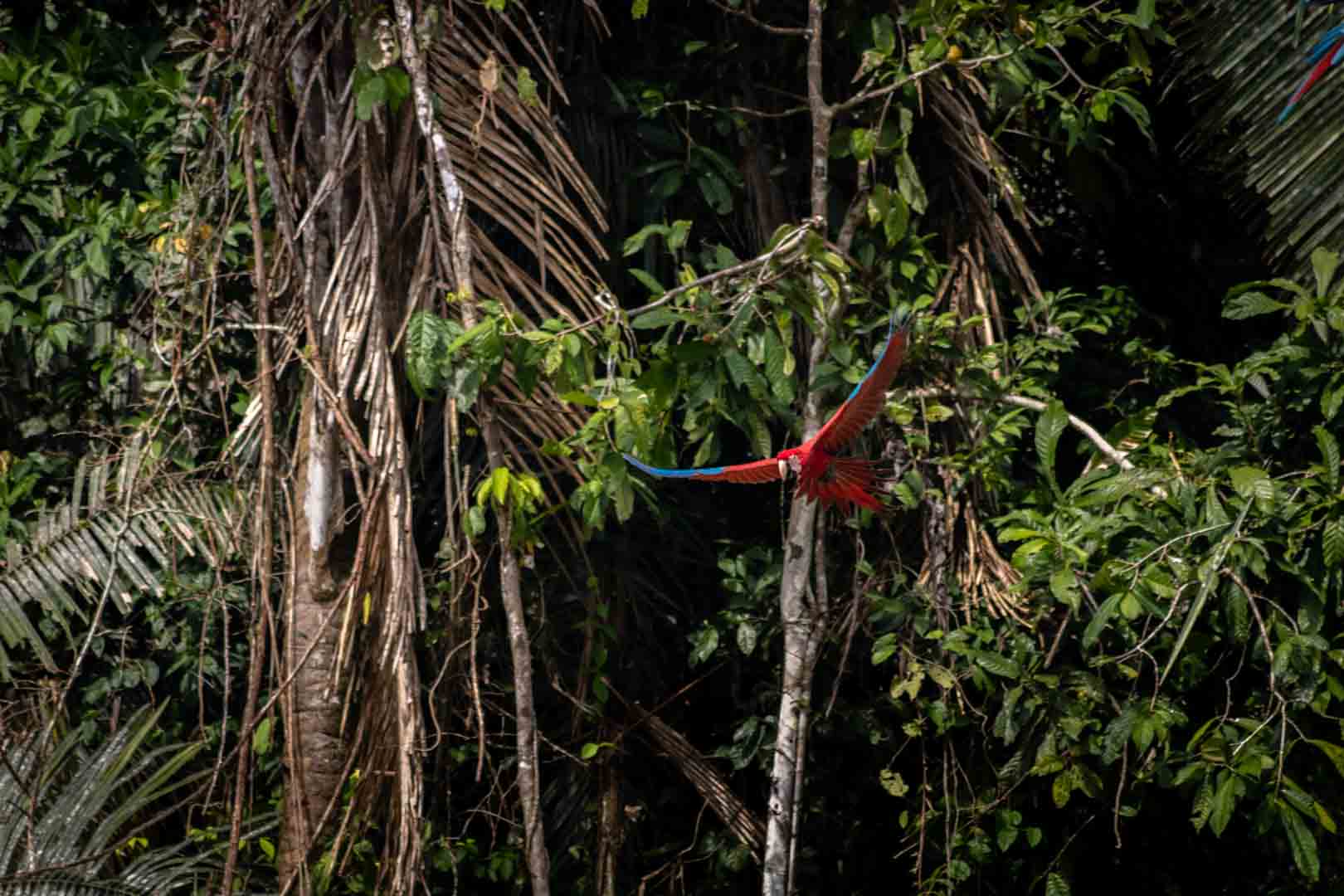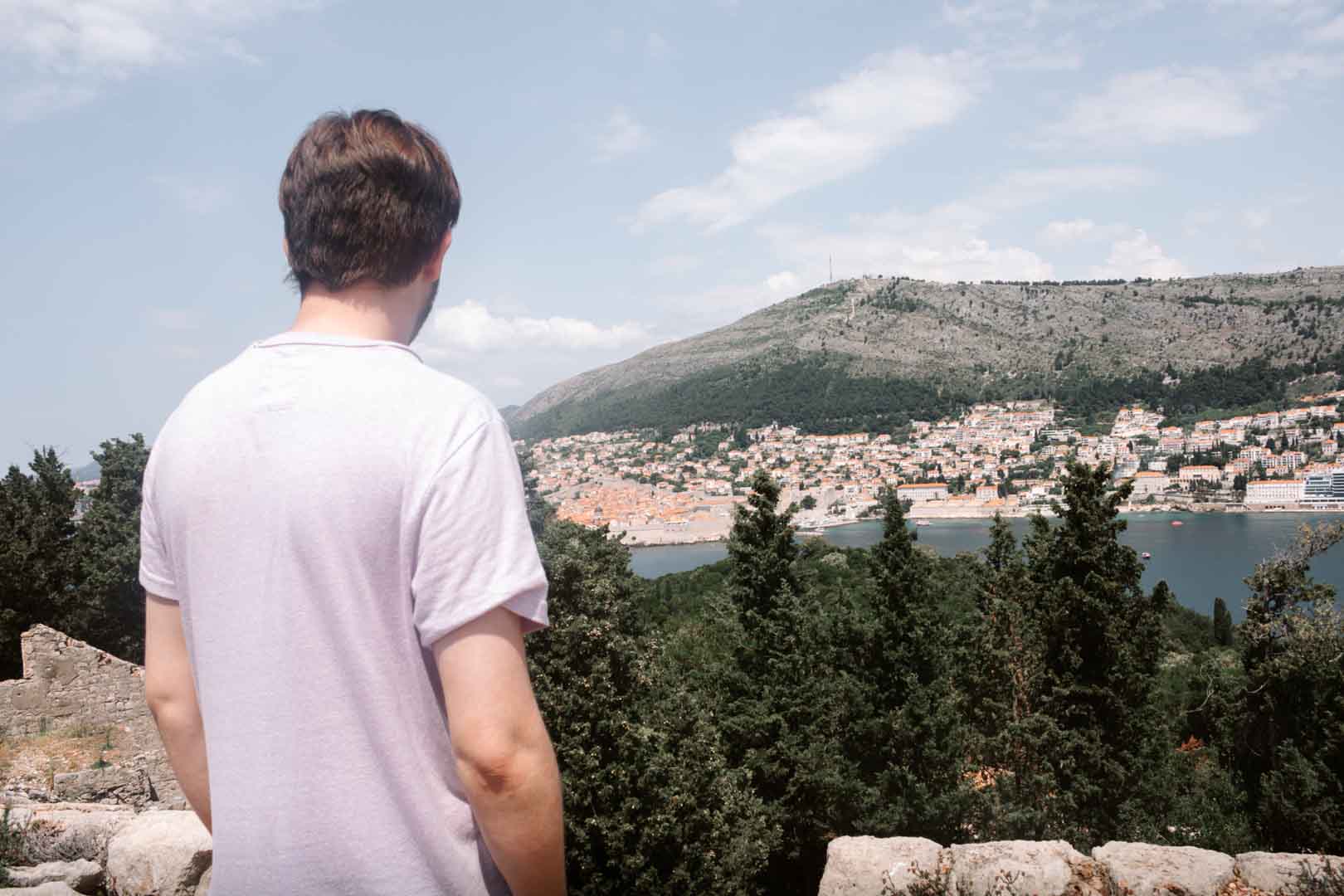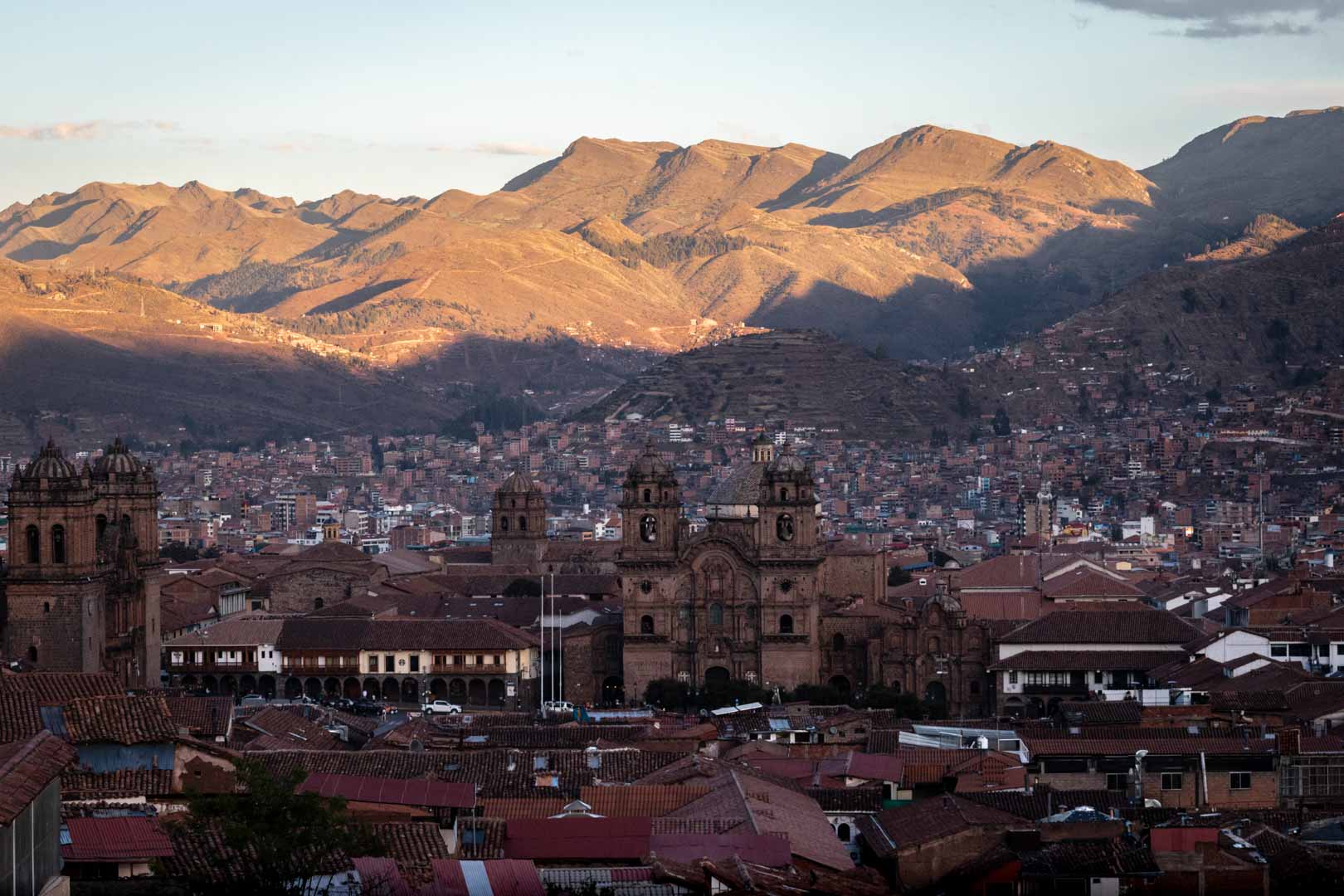Visiting Tambopata National Reserve: What You Need To Know!
Last Updated: January 13 2024
If there’s one place you must include on your Peru itinerary (aside from the mighty Machu Picchu) it’s Tambopata National Reserve. This magical place is part of the Amazon Rainforest and is one of the best places in the country for spotting wildlife!
Covering an impressive 274,690 hectares, it’s no wonder this reserve is so biodiverse. Unlike many areas of the Amazon, it’s surprisingly accessible too, which makes it a popular tourist destination.
This guide will cover everything you need to know about visiting Tambopata National Reserve. That includes how to get there, the best place to stay, and the things you can get up to!
Some posts on this site contain affiliate links. If you buy or book something through these links, we earn a small commission, but at no extra cost to you! If you want to learn more, you can take a look at our privacy policy!
Where is Tambopata National Reserve?
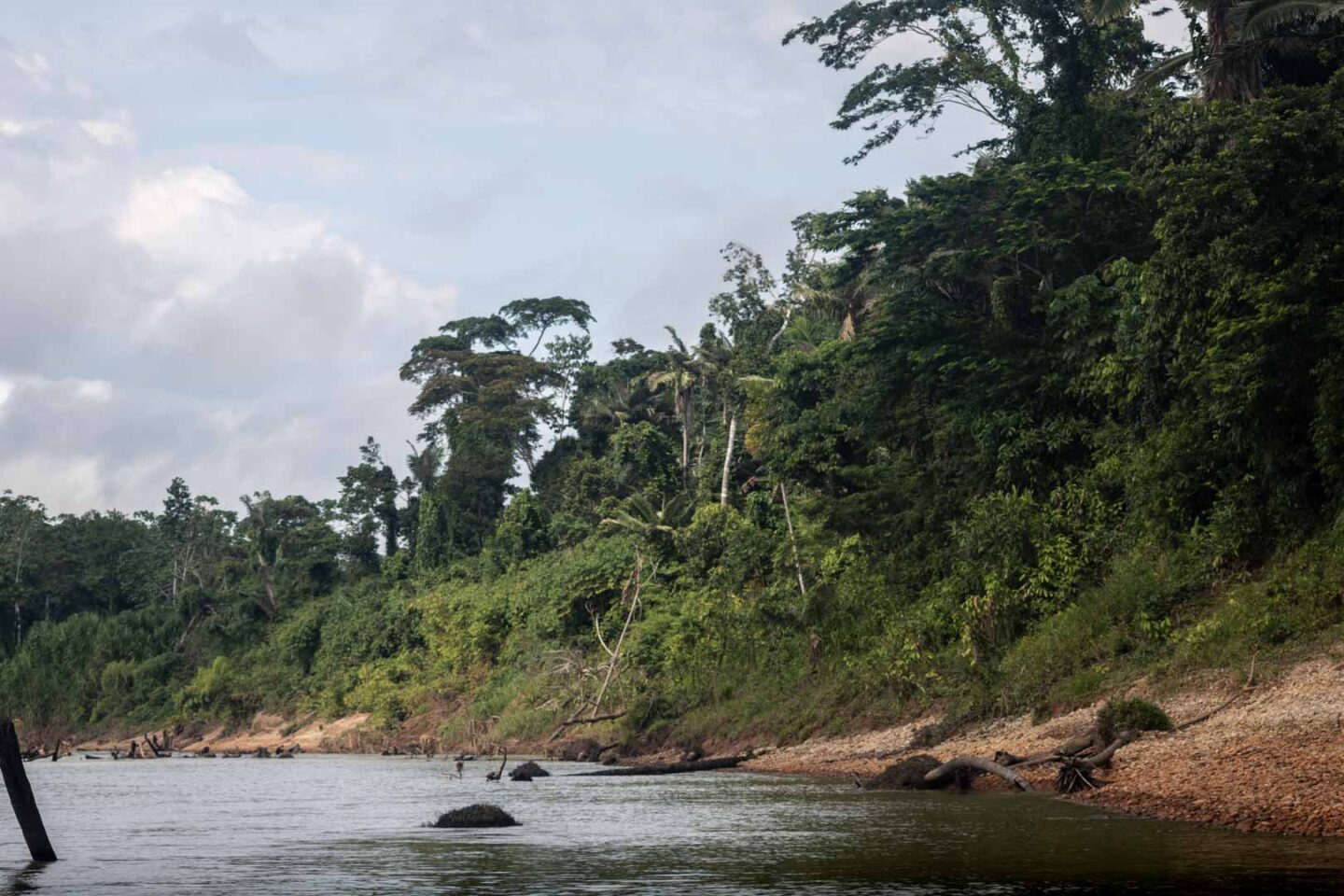
Tambopata National Reserve is located in Southeastern Peru, with the closest city being Puerto Maldonado. It overlaps the regions of Madre de Dios and Puno and isn’t too far from the Bolivian border.
Tambopata National Reserve is primarily made up of floodplains and lowland forests and is best accessed via boat. It’s one of the largest reserves in the country so has a lot to offer travellers.
There are several rivers within the reserve and these all eventually flow into the Madre de Dios River. As such, you’ll find that many of the forest lodges are located along these tributaries.
The History of Tambopata National Reserve, Peru
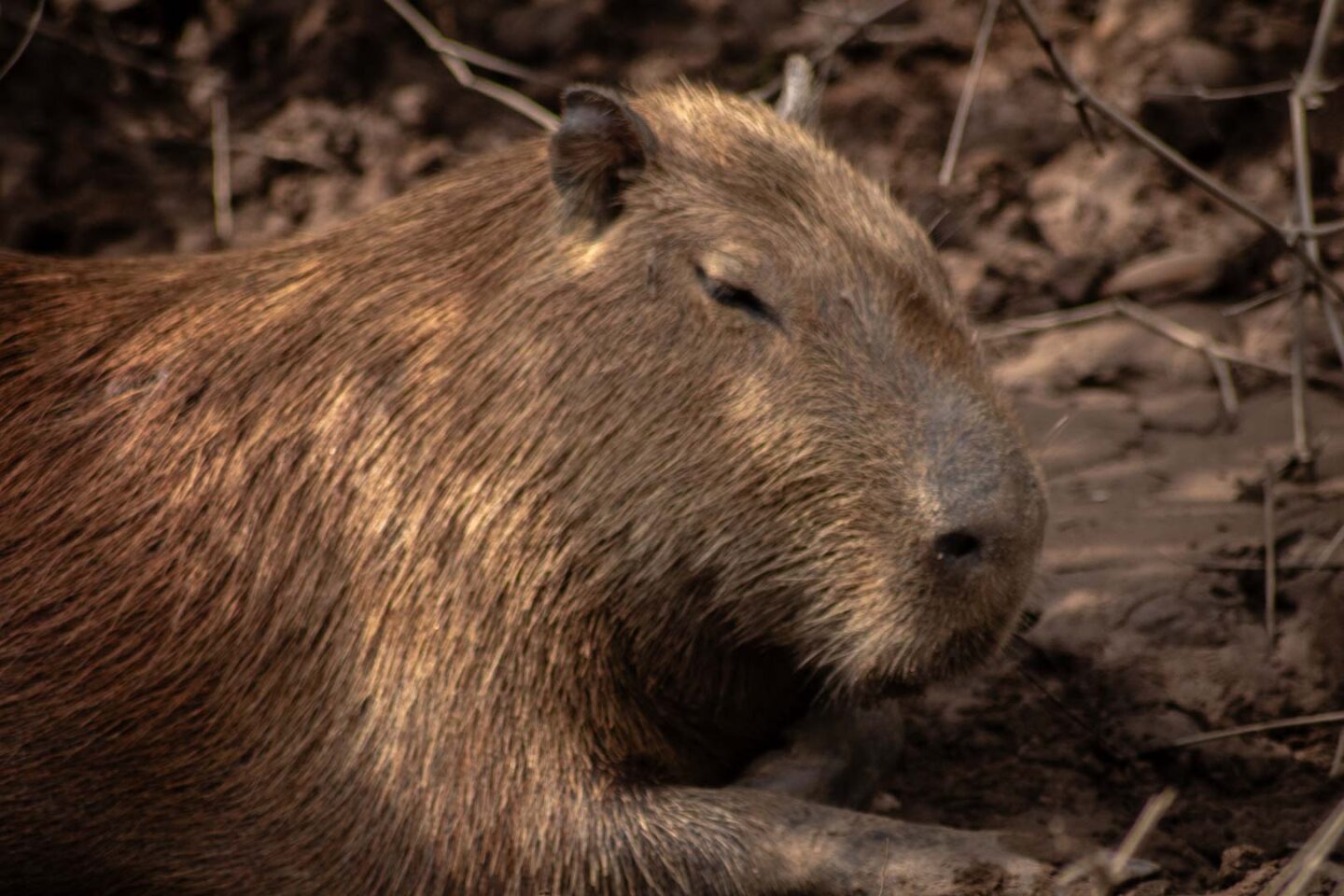
Tambopata National Reserve is the second-largest reserve in Peru and is known for its incredible biodiversity. Not only are there plenty of endangered species here, but this area is also home to a variety of medicinal plants.
As such, the Peruvian government prohibited logging and hunting here in 1977, although of course, indigenous communities still reside in this reserve. These native communities have been recognised by the local governments, and have their own specific areas!
The Reserve was created in 2000 to protect the lowland forest alongside the Tambopata River. Since then, tourism has been growing, and it’s now a popular place to visit within the Peruvian Amazon.
Flora & Fauna of Tambopata National Reserve
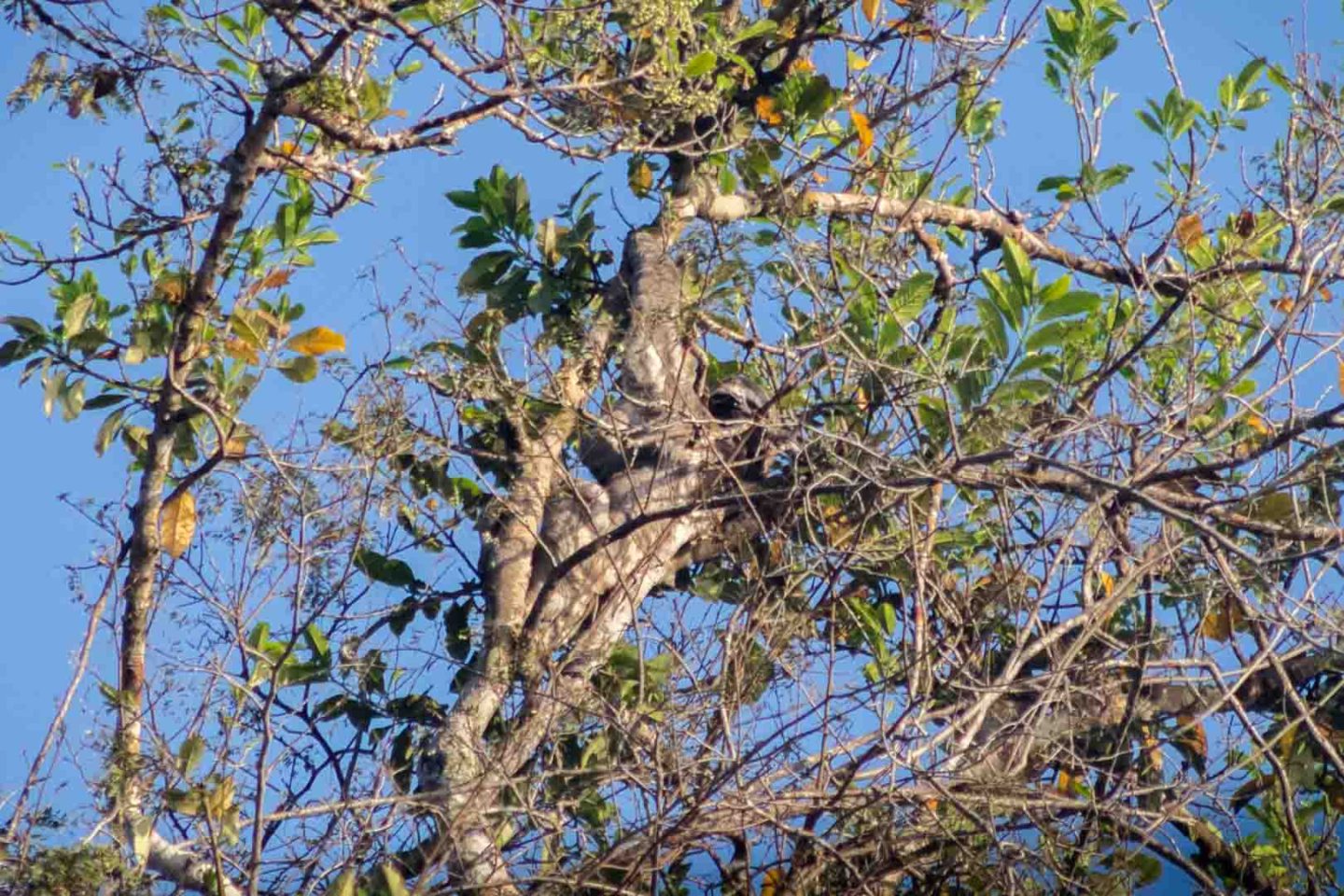
Tambopata National Reserve is one of the best places in Peru for wildlife watching (as well as the Ballestas Islands). Honestly, if you’re a nature lover, then you can’t miss out on visiting this incredible destination.
Within this nature reserve, you’ll find over 160 species of mammals, around 600 bird species, and more than 10,000 plant species. In fact, Tambopata is home to a variety of towering trees including the Capirona Tree and The Shihuahuaco Tree.
The highlight of any trip to the reserve is spotting a jaguar, although these can be rather elusive. Other popular mammals that you might get to spot include the tapir, giant otter, sloths, and giant anteaters. Pumas are also located in this reserve although they’re rarely seen!
While in Tambopata National Reserve, you’ll want to keep an eye out for monkeys too, as there are several species that you can spot. Don’t forget about the variety of colourful birds either, including macaws, toucans, and the kingfisher.
Visiting Tambopata National Reserve
The best time to visit Tambopata
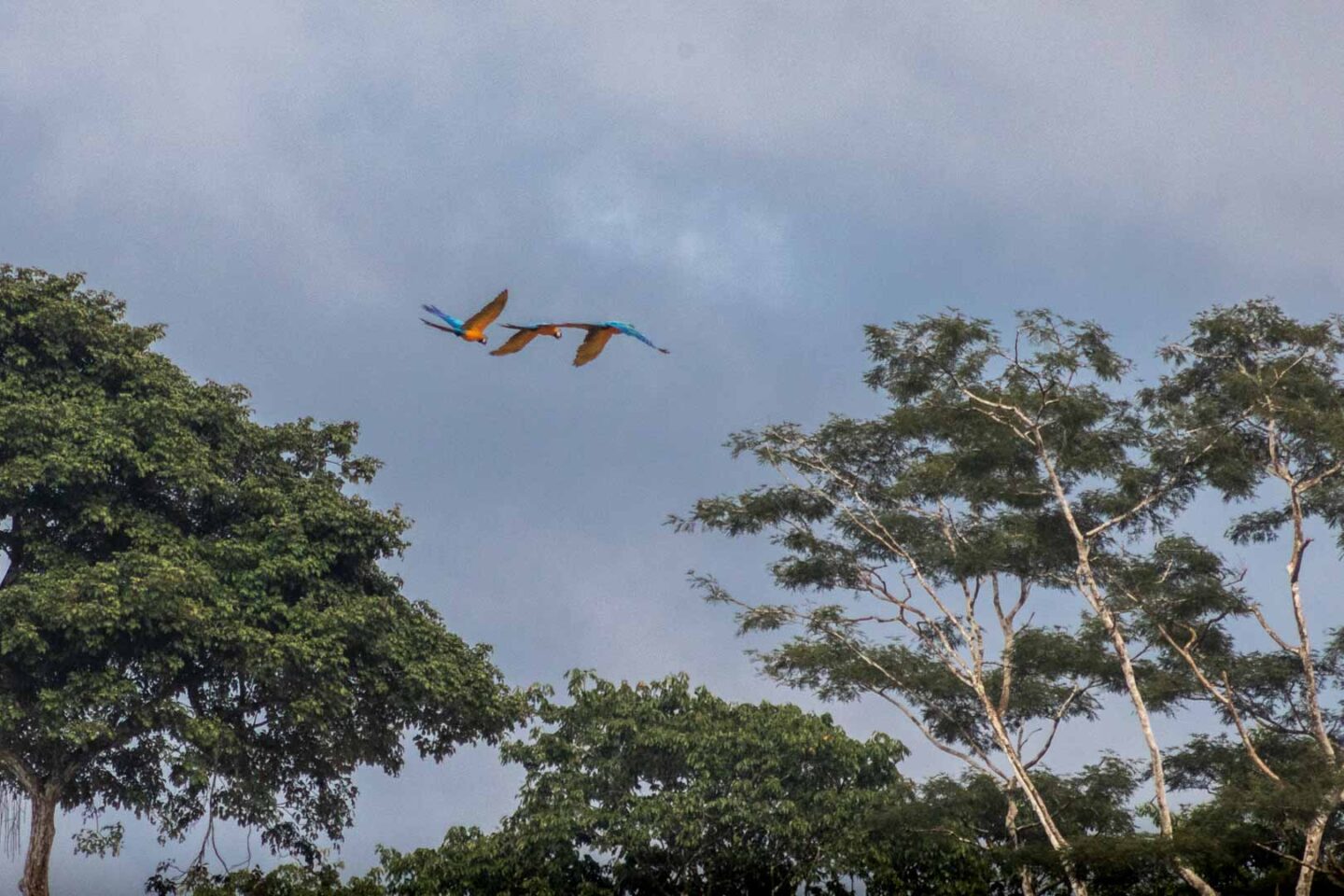
The dry season in Tambopata runs from April to November. However, you will still experience some rainfall during this time. Personally, we stayed here during May and found it to be a great time to visit.
However, temperatures during this time regularly reach over 30°C and the humidity is intense.
The dry season does tend to offer great wildlife-watching opportunities though as the animals search for water and nutrients, so that’s always a bonus! There’s also less water at this time of year, so aquatic animals are easier to spot.
The wet season runs from November to March, with the rainiest months being January and February. Although you’ll encounter more rain, this is the time of year when macaws are nesting, so it’s another great time to visit.
Some clay licks do encounter more activity during the wet season due to the increase in forest fruits, so no matter when you visit, you’ve got a good chance of spotting wildlife.
How to get to Tambopata

Although Tambopata is located in the Amazon rainforest, it’s relatively accessible. To reach the reserve, you’ll first need to get to Puerto Maldonado, which is the Southernmost city in the Peruvian Amazon.
This incredible city is nestled within the jungle and is often referred to as the ‘Gateway to the Southern Amazon’. You may not think it, but this city has road access and it’s around a 9-hour drive from Cusco. As such, it’s best to travel here by overnight bus, especially as they’re very comfortable.
Your other option to reach Puerto Maldonado is by air, with flights coming in from Cusco or Lima.
If you opt for a package tour with an operator, then it’s likely the company will pick you up once you reach the city. Many of the lodges are then located along the river, so you’ll have to catch a boat out to them.
The main areas of Tambopata
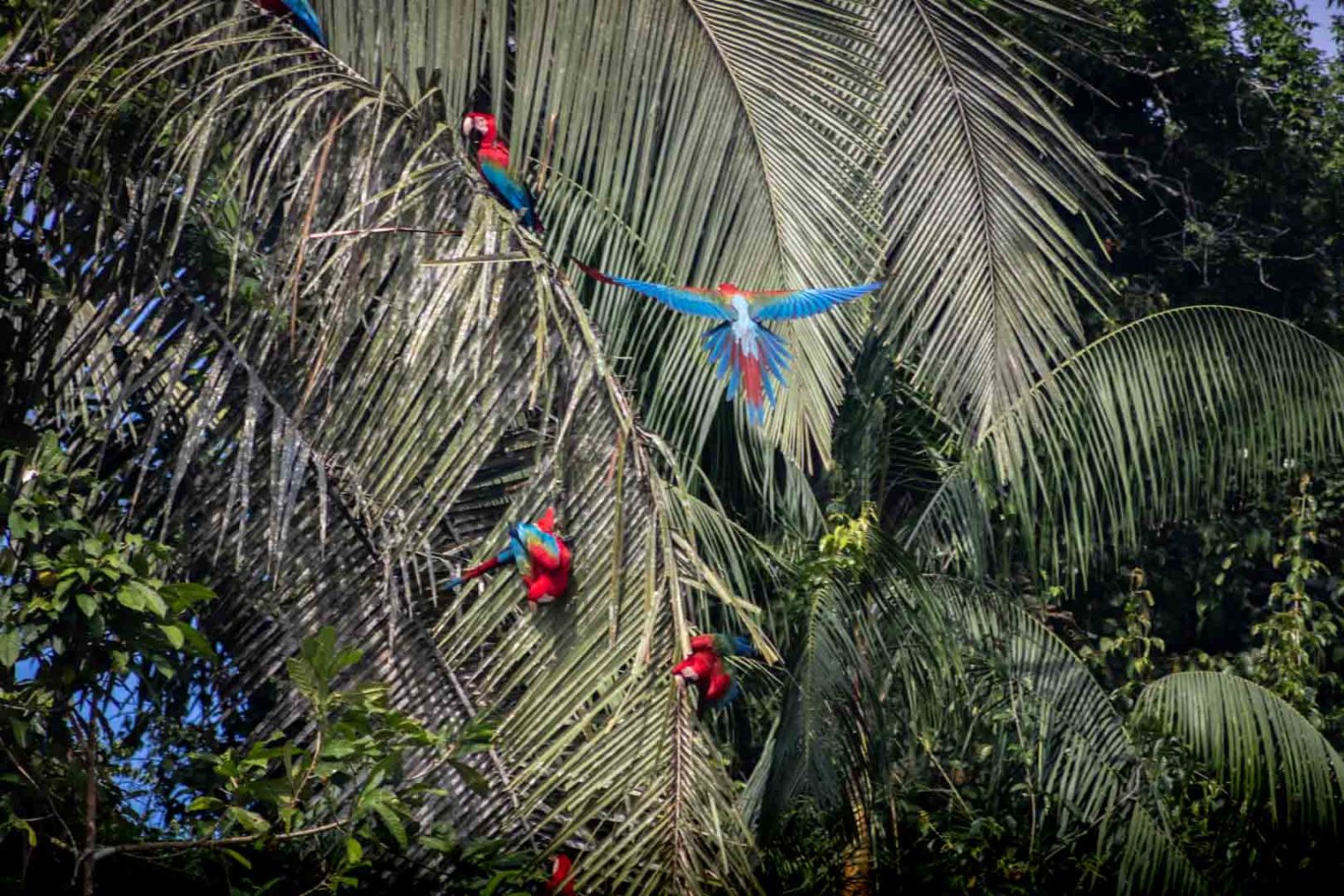
There are three main areas to stay that are located in or near the reserve. These are Río Tambopata, Río Madre de Dios & Sandoval Lake. These are typically the most popular areas for tourists, and they can easily be accessed from the city of Puerto Maldonado.
Río Tambopata is one of the major tributaries of the Río Madre de Dios. You’ll find many of the area’s jungle lodges along this river, making it a great place to stay.
Río Madre de Dios is one of the best rivers in the Peruvian Amazon for wildlife watching, and it’s actually shared by Bolivia too. It’s part of the Amazon River watershed and is another popular area to stay in.
Finally, there’s Sandoval Lake which can be visited on a day trip from Puerto Maldonado. However, we’d recommend staying overnight, as this gives you a chance to explore the area at sunrise and sunset, both great times for wildlife watching!
Where to stay in Tambopata
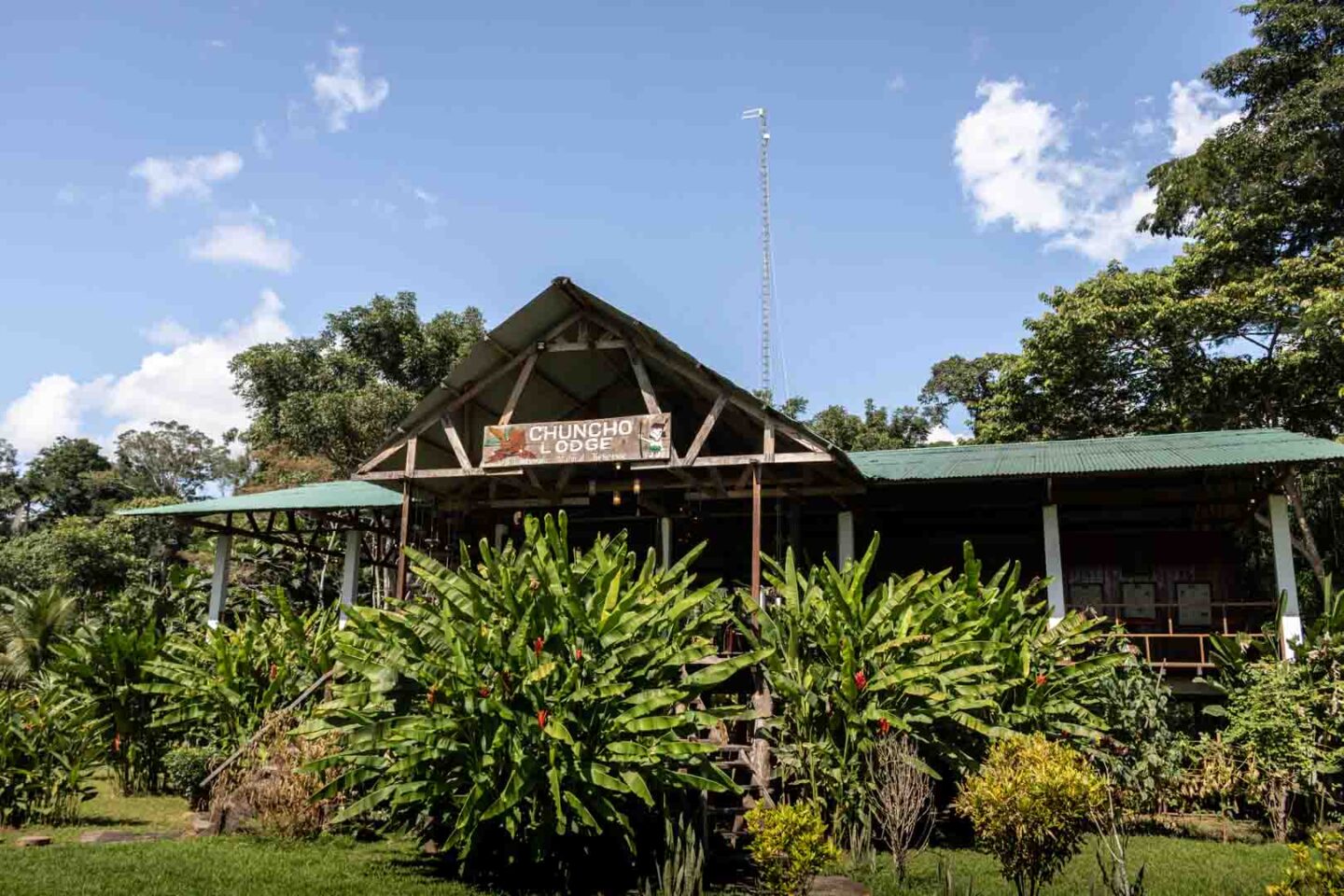
For those on a budget, your best option is to stay in Puerto Maldonado itself and then take day trips out to the reserve. This could be a river cruise or a trip to Sandoval Lake, but allow at least two or three days in the city!
However, we’d highly recommend staying at Chuncho Lodge if you’re visiting Tambopata National Reserve. We stayed here during our time in the Peruvian Amazon, and it was the highlight of our Peru trip! (Not sponsored, we just had a fabulous time here).
We opted for this 4-day Tambopata Expedition which includes accommodation, food, transport, a guide, and excursions. Our guide was fantastic and he helped us spot a wide variety of wildlife including caiman, capybaras, monkeys, and a sloth.
Some other great places to stay in Tambopata include:
- The Tambopata Research Center
- Refugio Amazonas Lodge
- Posada Amazonas Lodge
- Ecoamazonia Lodge
- Inkaterra Reserva Amazonica
Just make sure you check out each of the options to see which one’s most suited to you!
Booking.comTambopata National Reserve Tours

If you’re still not sure of how to visit the Peruvian Amazon then there are some fantastic Tambopata Reserve tours to choose from. We’d highly recommend booking with Chuncho Lodge as we had the most fabulous time, but there are other options out there.
The main thing to note here is that many of the tours visit a place called Monkey Island. Here, you’ll find ‘pet monkeys’ that are fed, so you aren’t actually getting a wild experience. For ethical reasons, we’d avoid opting for a tour that includes this place!
To ensure you pick the perfect option for you, make sure you weigh up the different tour operators and Amazon lodges. Each tour will include different destinations and excursions, so you’ll want to find something suited to you.
The tours will also differ in duration and price, so it’s all about the timeframe you have and your budget!
Top tips for visiting the Tambopata Rainforest
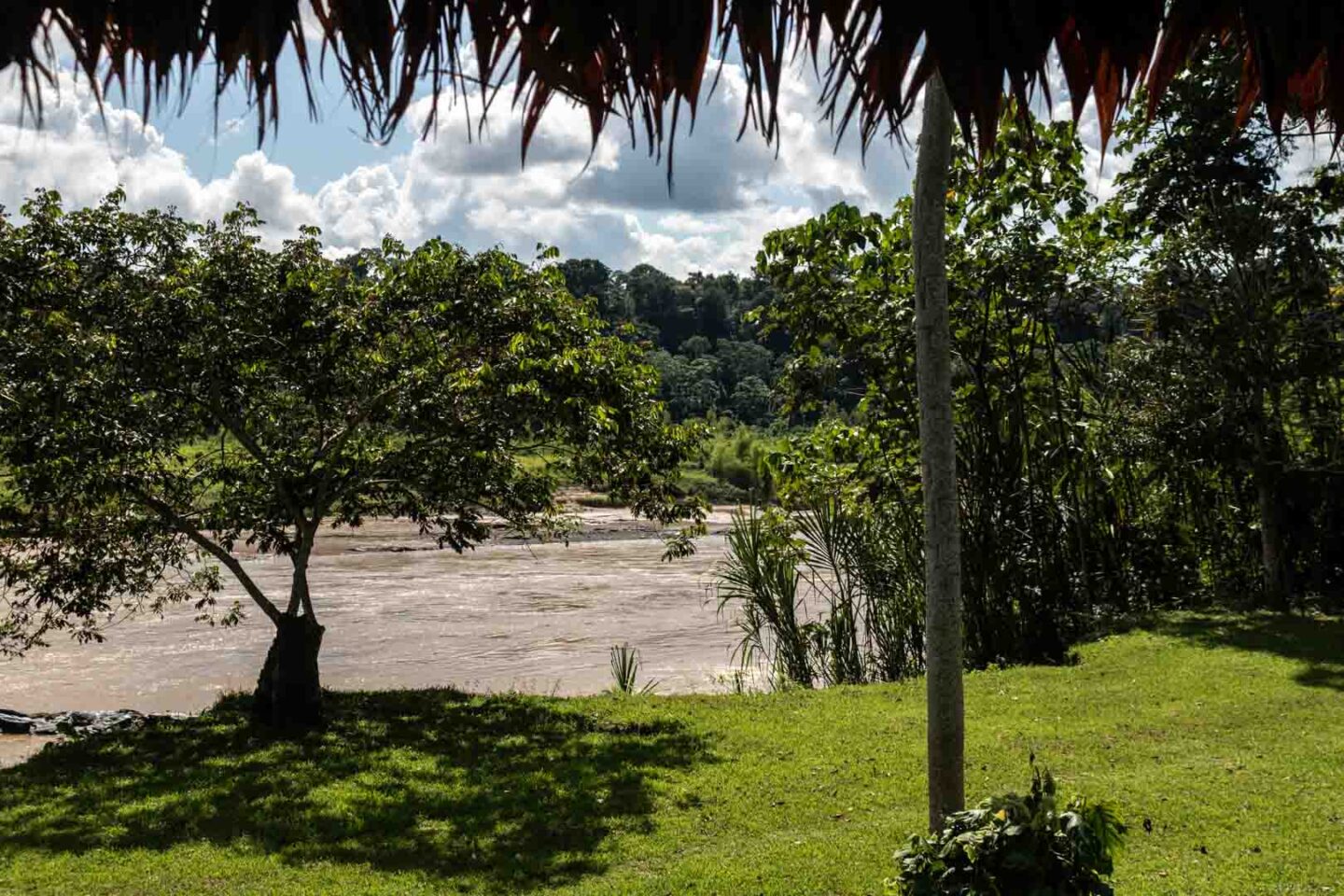
Tambopata National Reserve is one of the best places in South America for spotting wildlife so it needs to be included on your Peru itinerary!
Here are some travel tips to ensure you have the best visit:
- The temperatures in the jungle are intense, so you’ll want to ensure you wear light cotton clothing. Even better, ensure your clothing is waterproof as you’re bound to encounter some downpours.
- There are tons of wildlife-watching opportunities in Tambopata so make sure you pack your camera. If you can, try to purchase a zoom lens before your visit to ensure you get great photographs.
- We’d highly recommend getting your Yellow Fever vaccination before heading to Tambopata. You’ll also want to check if any other vaccinations are required for your Peru trip.
- It’s mandatory to visit the reserve with a guide so keep that in mind. Luckily, if you book a package tour, many of these include a tour guide, so you won’t have to pay extra for this (usually).
- If you’re visiting Sandoval Lake, you’ve got the opportunity to get your passport stamped. The stamp consists of a giant otter, so is a really cool one to have in your passport!
The Best Things to Do in Tambopata National Reserve
1. Stay in a jungle lodge
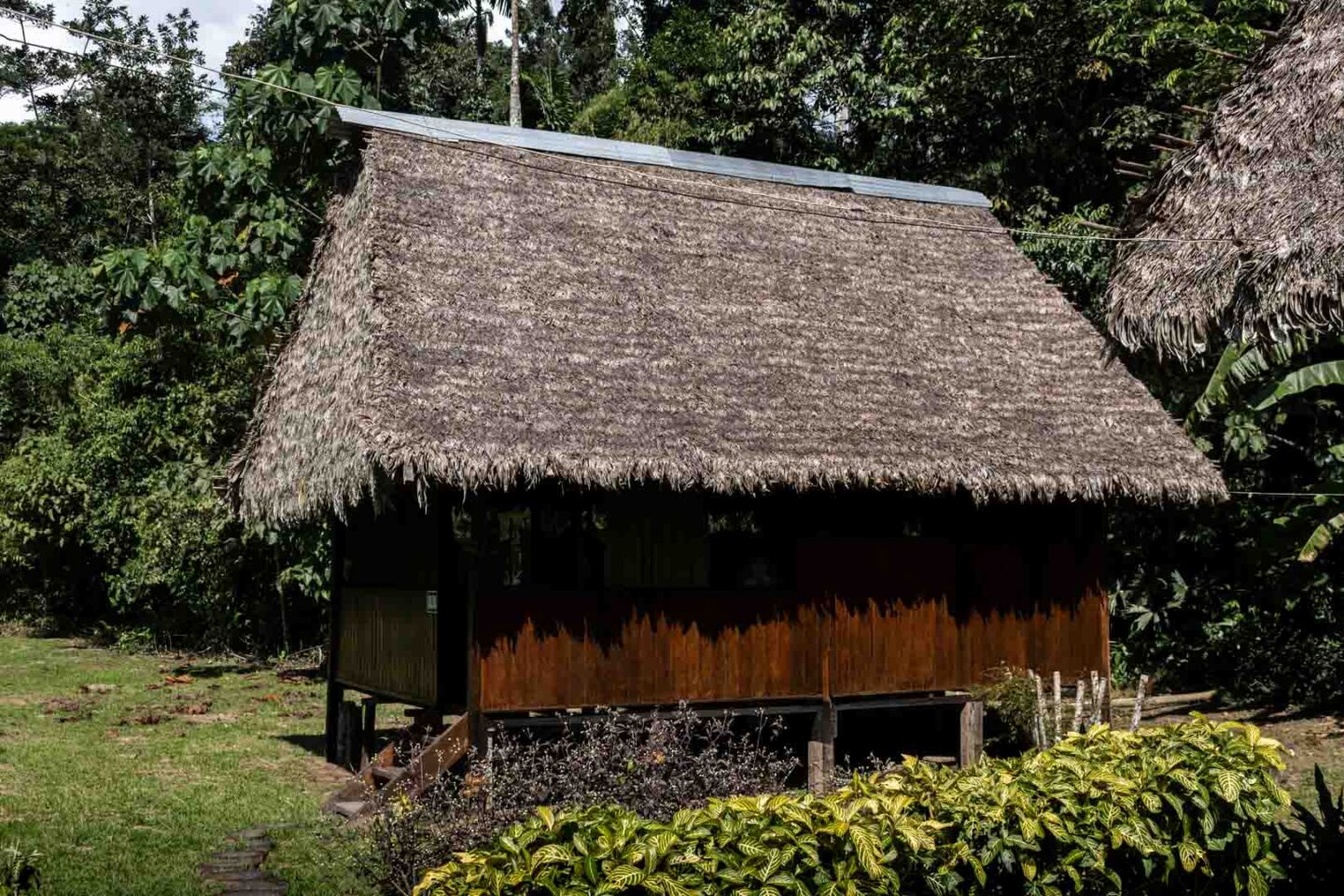
Although it’s possible to visit Tambopata on a day trip, we wholeheartedly recommend staying overnight. Better yet, allow at least 3-4 days for your trip. This way, you can experience the Amazon during the day and at night.
There are tons of fantastic jungle lodges to choose from, with popular options including the Tambopata Research Center, The Refugio Amazonas Lodge, and The Posada Amazonas Lodge.
However, our top choice would have to be Chuncho Lodge, which is where we stayed! This beautiful lodge is 100% locally owned and offers a variety of tours, including this Tambopata Expedition. The owner is lovely too, and is happy to answer any questions you have beforehand by email.
2. Head out on a river cruise
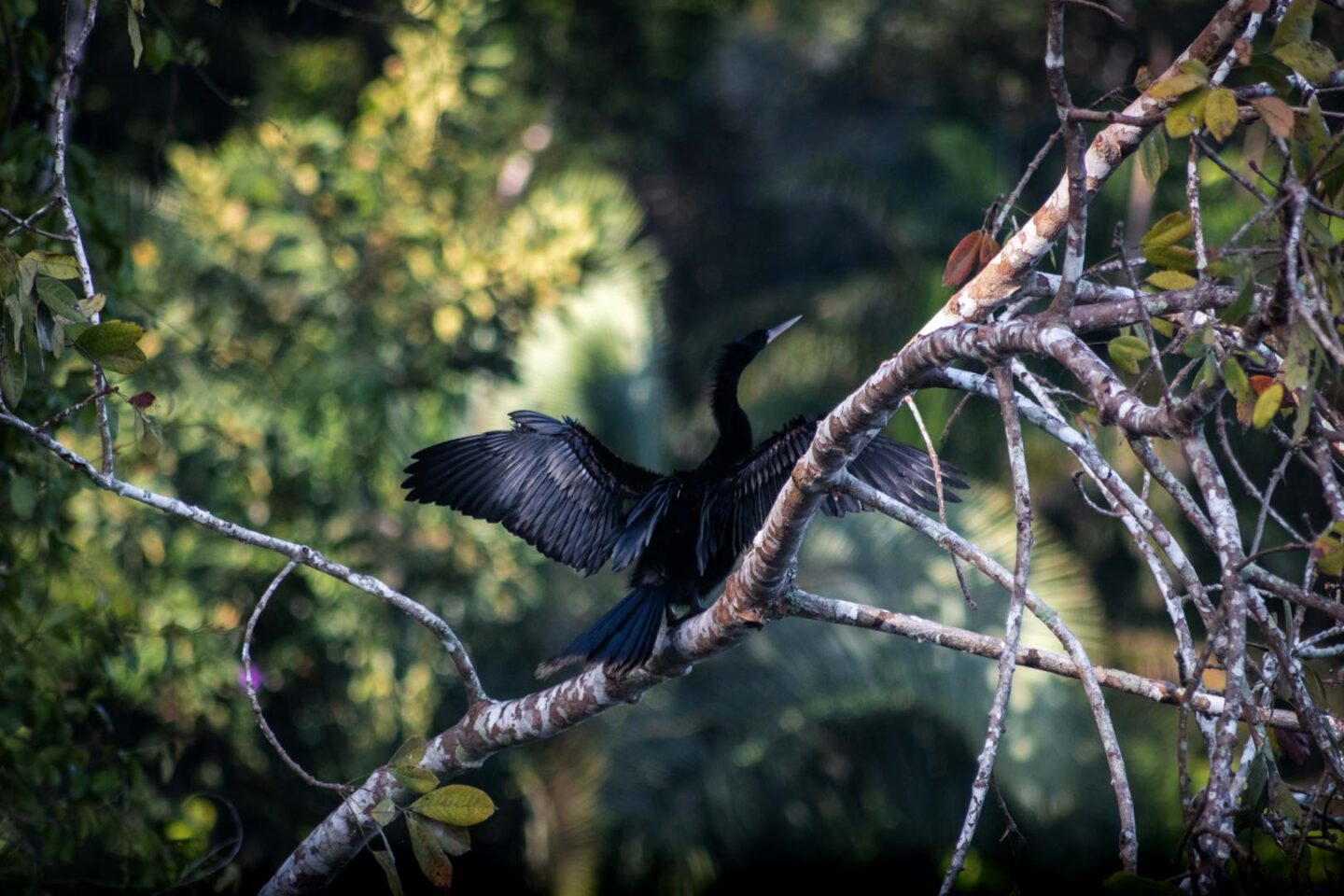
Going out on a river cruise is one of the best ways to explore Tambopata Reserve. Not only will you get to admire the breathtaking scenery, but a river cruise offers the best chance of spotting wildlife.
Depending on where you’re staying, you’ll head out along Río Tambopata or Río Madre de Dios. The river cruises usually last for at least an hour, and often longer if you’re heading to a specific destination.
While in the boat, keep your eyes peeled for caiman, anacondas, and giant otters. You’ll also want to keep an eye on the riverbank, as this is when you’ve got a chance of spotting capybara, jaguars, and tapirs.
3. Explore Sandoval Lake

Sandoval Lake is one of the best places to visit within Tambopata. To get here, you’ll need to take a boat from Puerto Maldonado, and then you’ll need to walk for around 3 km which will take about an hour.
We actually stayed overnight at a lodge along Sandoval Lake. This gave us the chance to head out on a boat trip to witness sunset and explore the lake at night, where we got to spot black caiman.
Sandoval Lake is one of the best places in Tambopata to see giant otters, but there’s also a variety of other wildlife you can see. During our time here, we were lucky enough to spot a gorgeous sloth!
4. Visit one of the reserve’s clay licks

If you’re heading to the reserve to witness the Amazon come to life, then going to a clay lick is one of your best options. The Chuncho Clay Lick used to be the most popular in this area, but we visited a relatively new clay lick.
On our visit, we got to spot hundreds of parrots and macaws taking nutrients from the clay lick. The colours were insane, and it was the perfect place to have a spot of breakfast.
Not only that, but we got to spot howler monkeys here too. If you only visit a couple of places within the reserve, then make sure you head to a clay lick!
5. Go on a night walk
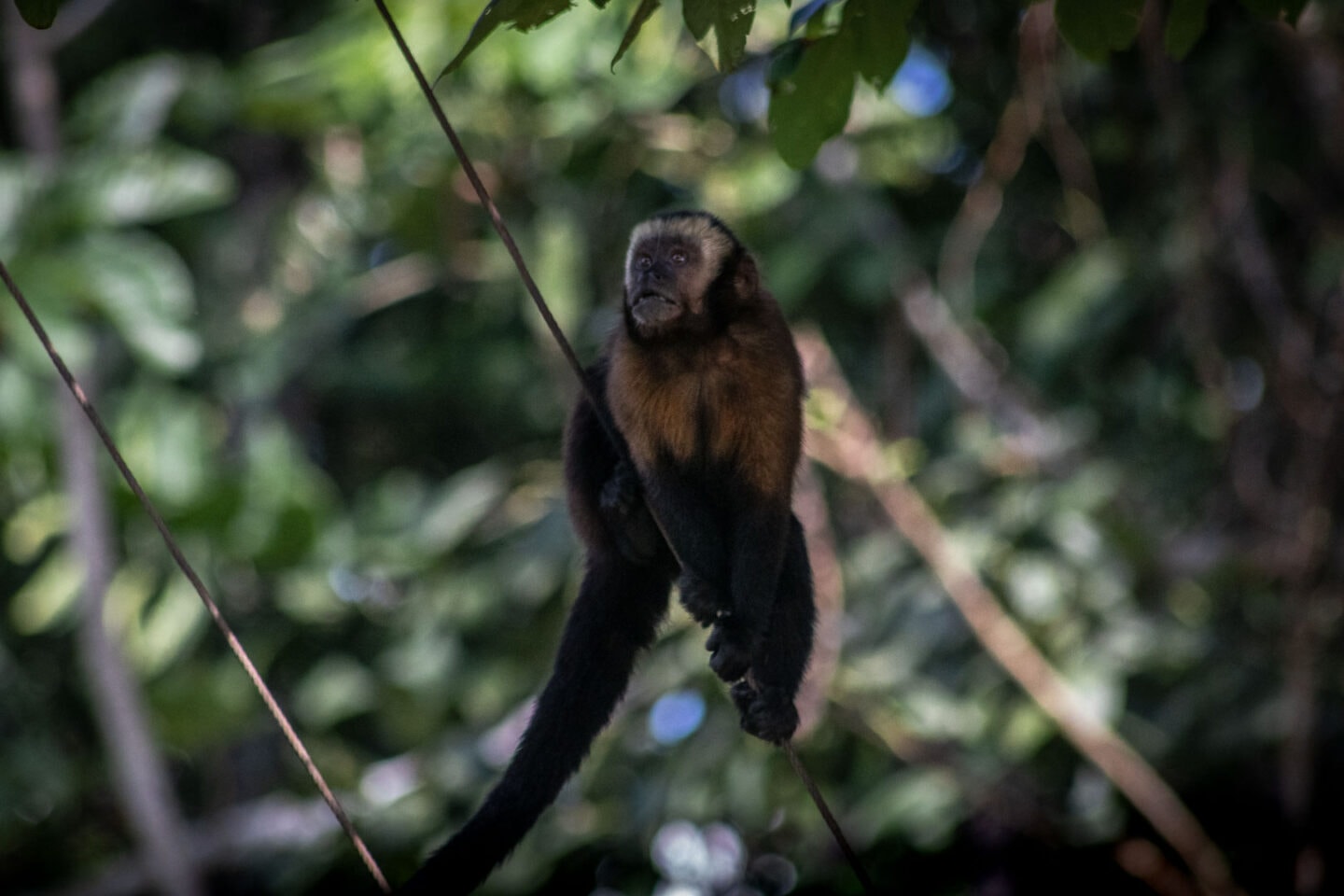
If you’re feeling daring then why not head out on a night walk in the jungle? During our stay, we went on two night walks with our guide, and they left us with memories to last a lifetime!
Now, the Amazon Rainforest is absolutely amazing during the day, but it’s pretty darn scary at night (yes, we’re not afraid to admit it haha).
The jungle comes alive at night with noises and plenty of creepy crawlies, so keep your eyes peeled for tarantulas. You’ve also got a great chance of spotting snakes too. Don’t worry though, as your guide will spot them way before you do!
6. Admire the views from a canopy tower
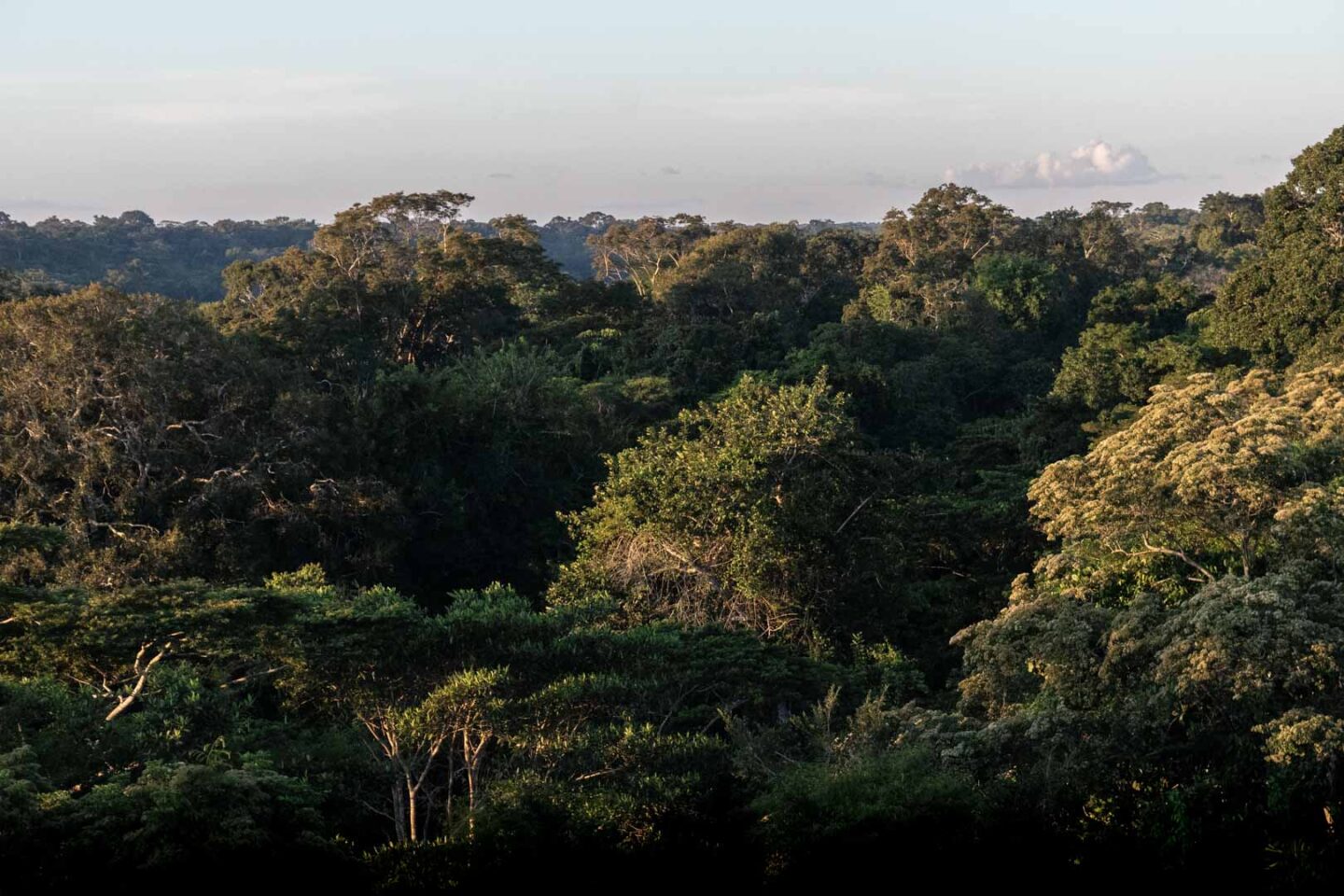
There are several canopy towers in Tambopata National Reserve. No matter which one you visit, you’ll be treated to jaw-dropping views of the rainforest canopy.
From the top of these towers, you’ll also get to spot a wide variety of birdlife from toucans to macaws. Just be aware, that this activity may not be suitable for those with a fear of heights!
During our time in Tambopata, we stayed at Chuncho Lodge. From the lodge, there’s a 40-metre (131-foot) canopy tower just a short walk away. Watching the sunset from here and taking in the views, is one of the best experiences we’ve ever had.
7. Visit the native communities
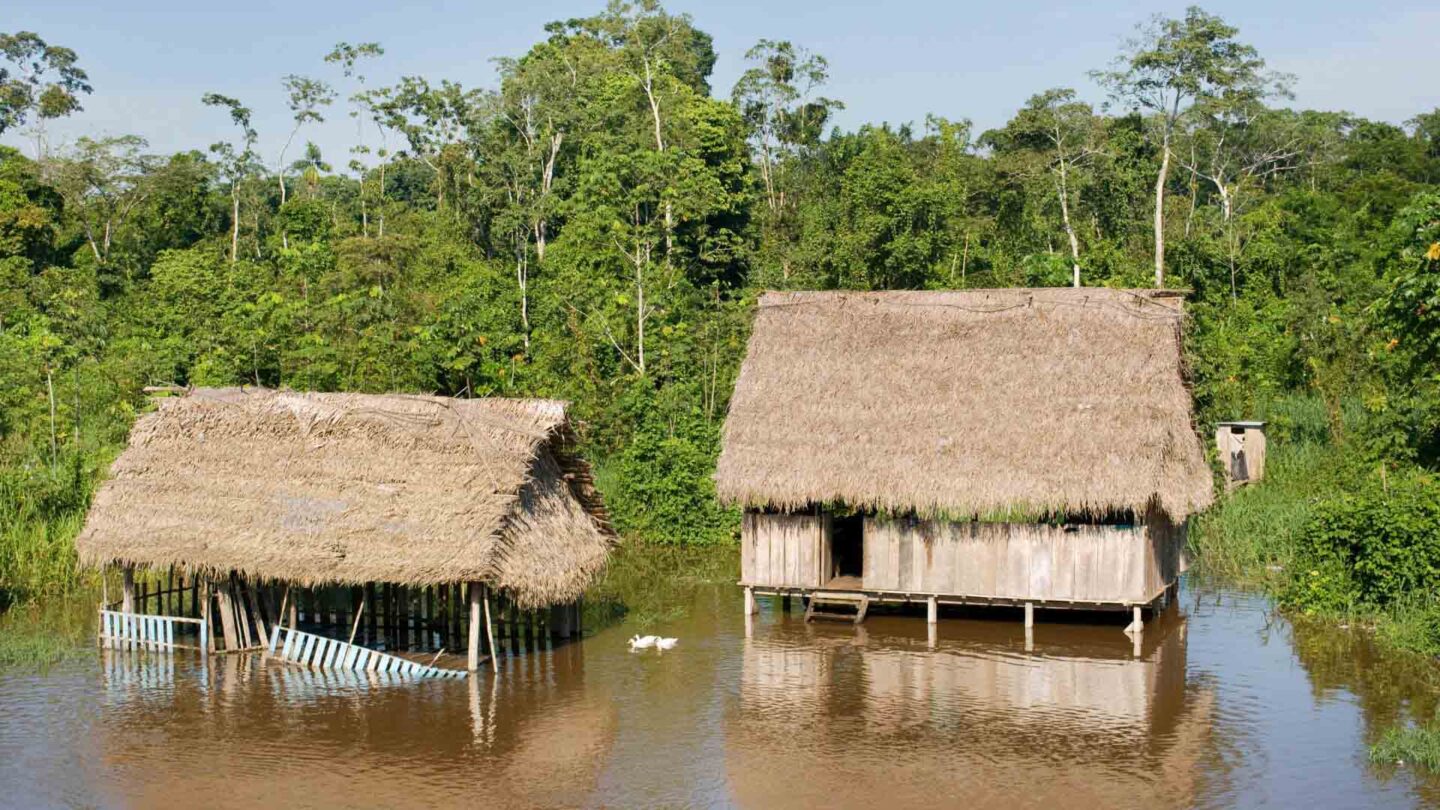
Like many areas in the Amazon Rainforest, Tambopata is home to indigenous communities. These native tribes include the Ese Eja Community, the Esa Axis, Matsigenka, and Harakbut.
Although many of these tribes don’t share connections with the modern world, they do welcome tourists who are keen to find out about their culture and traditions.
For the best experience, we recommend opting for a tour that includes a visit to one of these indigenous communities. Not all of them do, so you’ll want to check this in advance.
If you’re lucky enough to visit Tambopata’s native communities then make sure you fully embrace the experience as it’s not something you’ll soon forget!
8. Enjoy a jungle trek
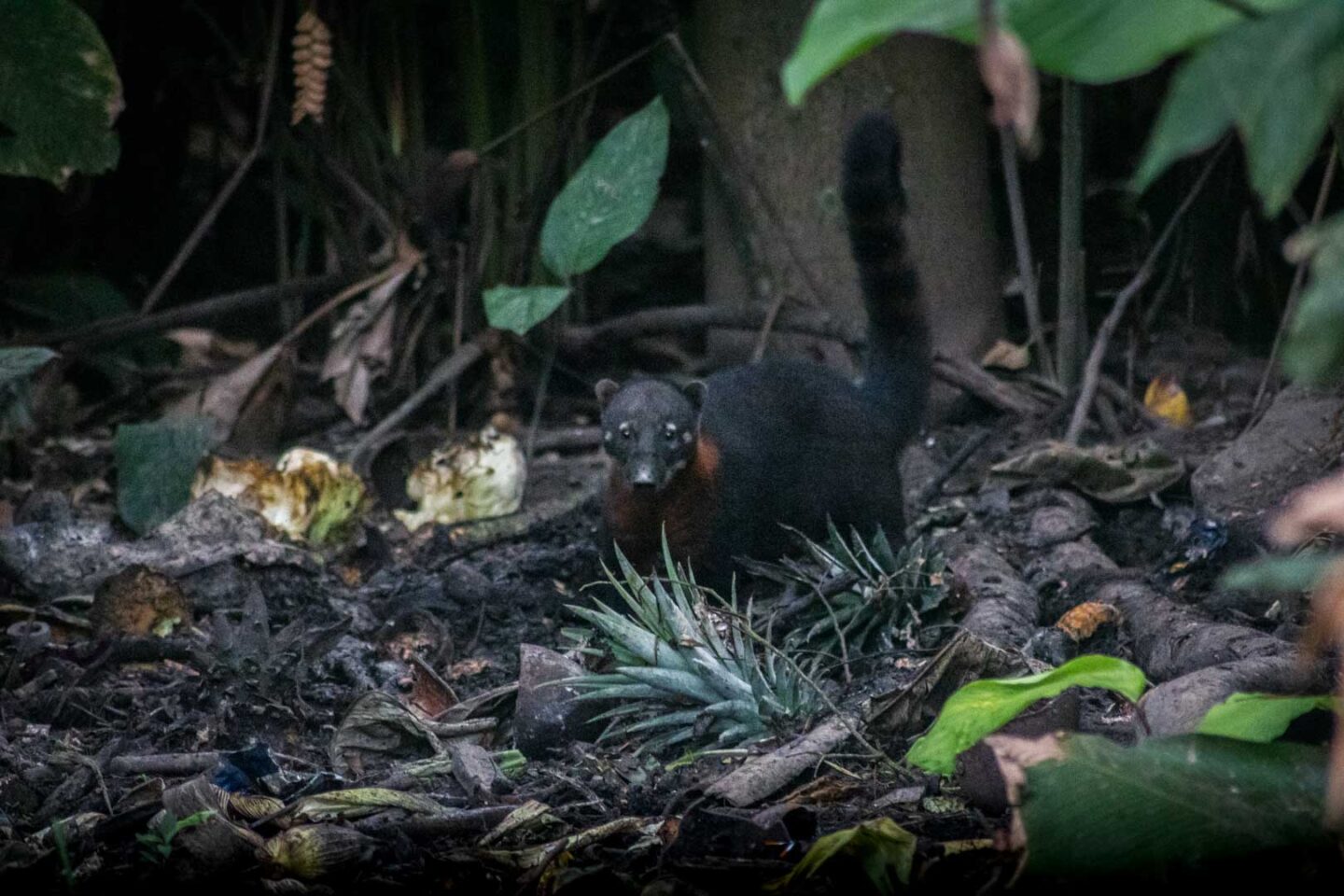
No visit to Tambopata is complete without heading out on a jungle trek. Although you can head out at night, we’d recommend going on a jungle hike during the day too, as it’s much easier to spot wildlife during the daylight.
We went on a couple of day treks during our time at Chuncho and got to spot a whole host of wildlife, especially birds. Not only that, but we saw a very large cat poo (which was apparently from an ocelot, jaguar, or puma).
Hiking during the day isn’t nearly as creepy as hiking at night, but we recommend doing both for the best experience!
9. Spend some time stargazing
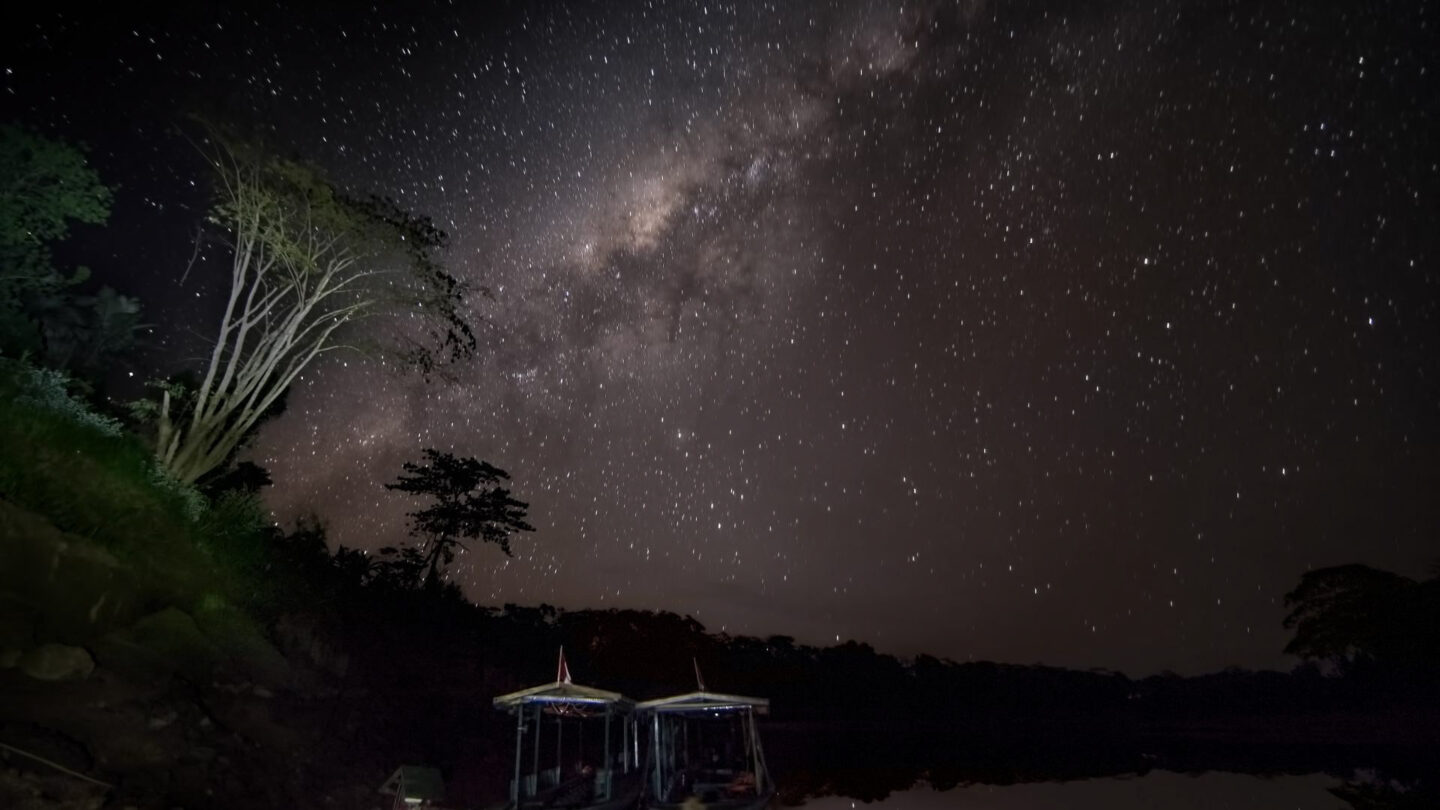
Due to the lack of light pollution, Tambopata National Reserve is a fantastic area for stargazing. You’ll find that the majority of lodges only have electricity for a few hours a day, so at night, you can enjoy the night sky without lights.
No matter where you stay in Tambopata, you’re bound to have some fantastic stargazing opportunities. Of course, this all depends on the weather and how cloudy it is!
In our opinion, Sandoval Lake is one of the best locations for stargazing, as we got to see shooting stars and the Milky Way from here, all on our evening boat trip.
10. Learn about the jungle’s plants
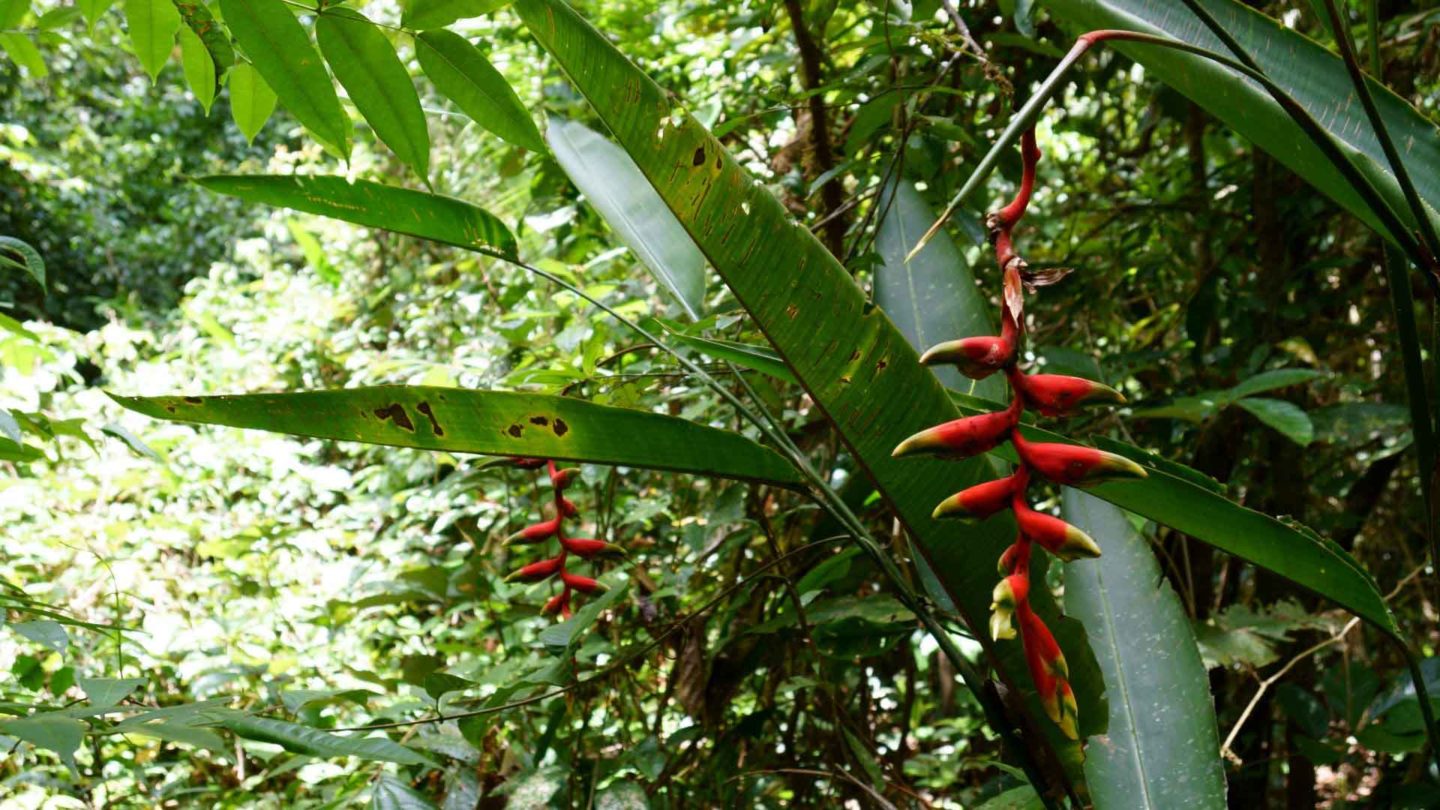
If you have the opportunity, we suggest heading out on a botanical walk with your guide. Many tours include this (ours did), and it’s a fantastic opportunity to learn about the Amazon’s native plants.
Not only will you get to see the reserve’s beautiful flora, but you’ll also get to learn about the area’s medicinal plants and their properties. Better yet, it’s likely you’ll get to try some new fruits and vegetables, so it’s certainly a worthwhile experience.
It’s no secret that people head to Tambopata to spot wildlife but learning about the jungle’s plantlife is an incredible experience on its own!
Frequently Asked Questions about Tambopata National Reserve
How many days do I need in Tambopata, Peru?
For the best experience in Tambopata, you’ll want to spend at least 3-4 days in the reserve. This gives you enough time to explore the wilderness, appreciate the landscapes, and spot some wildlife.
The longer you stay in Tambopata, the higher chances you’ve got of spotting wildlife too. Many of the species found in this reserve are elusive, so allowing yourself more time here increases your chances!
What is a good budget for Tambopata?
Peru as a country is very affordable, and the same goes for Tambopata. However, you’ll find that accommodation here tends to come in a package deal, with food, transport, and excursions included.
We spent around £400 each for our 3-night stay in Tambopata. That included our lodge, guide, meals, transport, and activities. However, we’d recommend allowing more for tips and any extra drinks or excursions! Our entrance fees were also included in the tour price, otherwise, you’ll need to consider that.
What is Tambopata National Reserve known for?
Tambopata Nature Reserve is most known for its biodiversity, which is why it’s such a great destination for wildlife watching. Home to over 160 species of mammals, around 600 bird species, and endless butterfly species, there’s a lot to see here.
Popular activities for spotting wildlife include jungle treks, night walks, and river cruises. You’ll also find some canopy towers within the reserve, where you’ll get a birds-eye view of the rainforest.
Is Tambopata part of the Amazon?
Tambopata is located within the Madre de Dios Region in Southeastern Peru. It’s found in the Peruvian Amazon so yes, it is part of the world’s largest rainforest.
The Peruvian Amazon covers nearly 2/3 of the country, yet it’s not very populated. Aside from Tambopata National Reserve, there’s also Iquitos and Manu National Park; two other popular spots with travellers.
Final Thoughts on Visiting Tambopata National Reserve
Tambopata National Park (also known as Reserva Nacional Tambopata) is undoubtedly one of the best places to visit in Peru. Home to beautiful landscapes, a wide variety of wildlife, and local communities, this incredible reserve has so much to offer.
Whether you’re looking to head out on a jungle cruise, go on a night walk, or admire the views from a canopy tower, this amazing destination has something for everyone!
If you have any questions about visiting Tambopata National Reserve, Peru then be sure to get in touch with us via Facebook, Instagram, or in the comments!
Here are some other guides that you may find helpful:
- The Best Things To Do In Aguas Calientes
- The Best Things To Do In Huacachina
- The Best Things To Do In Paracas
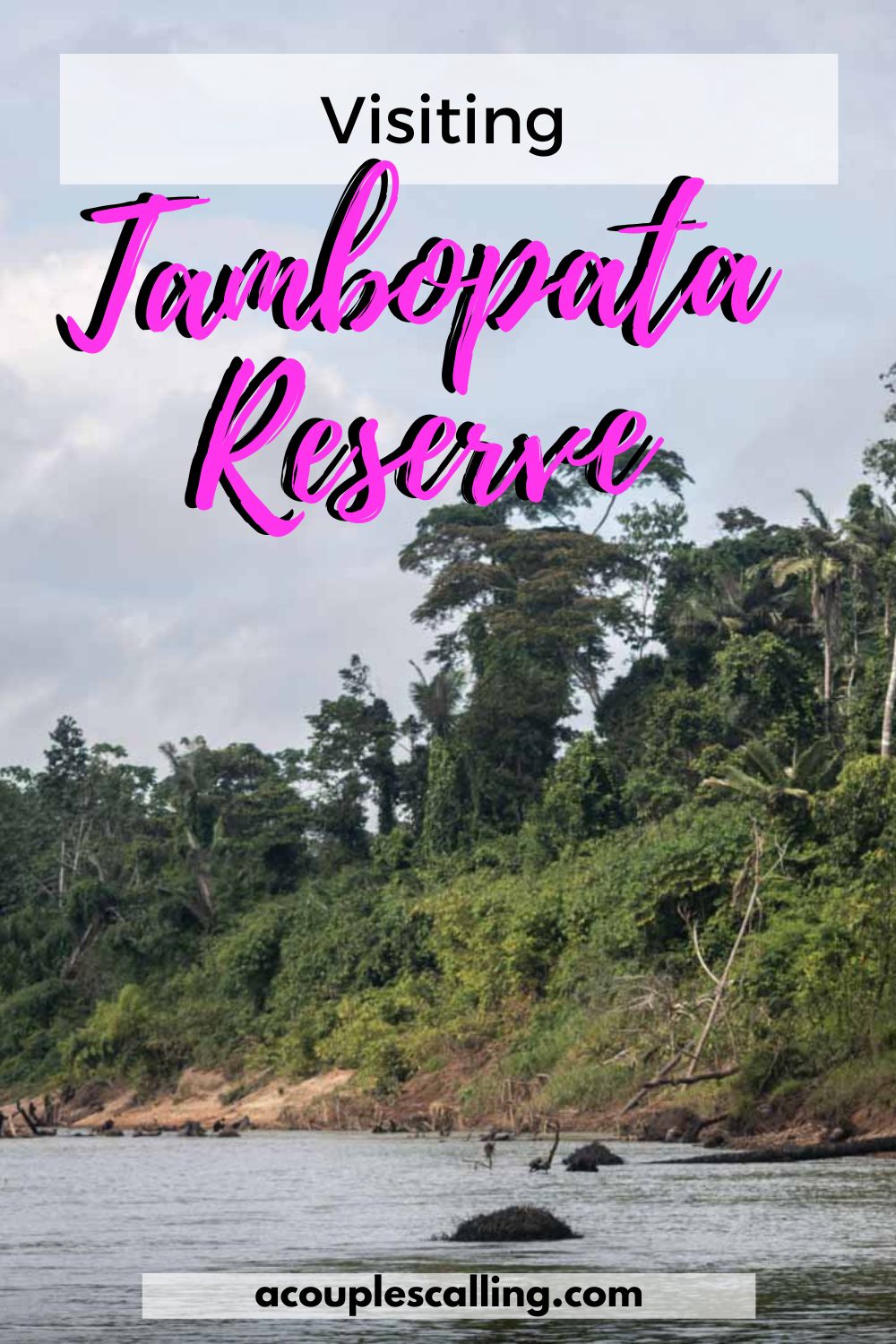
I’m one half of Acouplescalling. I'm passionate about all things travel and photography and I love sharing my experiences with others. I've seen a lot of the world already and I want to help as many people as I can do the same thing!

